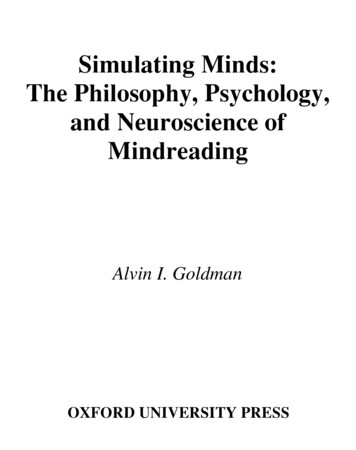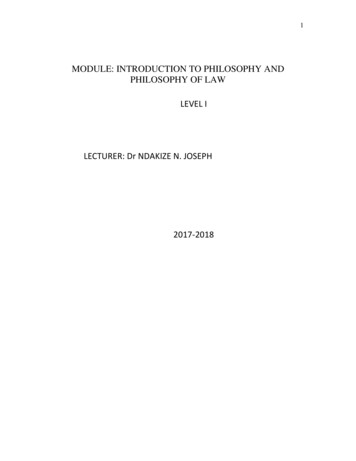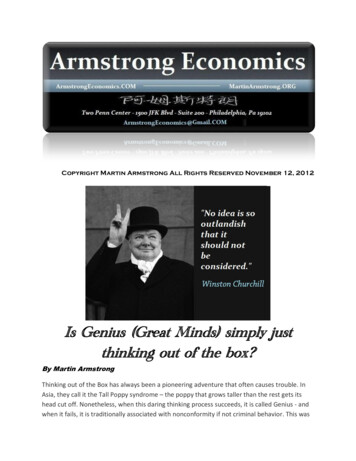
Transcription
Simulating Minds:The Philosophy, Psychology,and Neuroscience ofMindreadingAlvin I. GoldmanOXFORD UNIVERSITY PRESS
Simulating Minds
PHILOSOPHY OF MINDSeries EditorDavid J. Chalmers, Australian National UniversitySelf ExpressionsMinds, Morals, and the Meaning of LifeOwen FlanaganThe Conscious MindIn Search of a Fundamental TheoryDavid J. ChalmersDeconstructing the MindStephen P. StichThe Human AnimalPersonal Identity without PsychologyEric OlsonMinds and BodiesPhilosophers and Their IdeasColin McGinnWhat’s Within?Nativism ReconsideredFiona CowiePurple HazeThe Puzzle of ConsciousnessJoseph LevineConsciousness and CognitionA Unified AccountMichael ThauThinking without WordsJosé Luis BermúdezIdentifying the MindSelected Papers of U. T. PlaceEdited by George Graham andElizabeth R. ValentineA Place for ConsciousnessProbing the Deep Structure of the Natural WorldGregg RosenbergThree Faces of DesireTimothy SchroderGut ReactionsA Perceptual Theory of EmotionJesse J. PrinzeIgnorance and ImaginationOn the Epistemic Origin of the Problem of ConsciousnessDaniel StoljarSimulating MindsThe Philosophy, Psychology, and Neuroscience of MindreadingAlvin I. Goldman
Simulating MindsThe Philosophy, Psychology, andNeuroscience of MindreadingAlvin I. Goldman12006
1Oxford University Press, Inc., publishes works that furtherOxford University’s objective of excellencein research, scholarship, and education.Oxford New YorkAuckland Cape Town Dar es Salaam Hong Kong KarachiKuala Lumpur Madrid Melbourne Mexico City NairobiNew Delhi Shanghai Taipei TorontoWith offices inArgentina Austria Brazil Chile Czech Republic France GreeceGuatemala Hungary Italy Japan Poland Portugal SingaporeSouth Korea Switzerland Thailand Turkey Ukraine VietnamCopyright 2006 by Oxford University Press, Inc.Published by Oxford University Press, Inc.198 Madison Avenue, New York, New York 10016www.oup.comOxford is a registered trademark of Oxford University Press.All rights reserved. No part of this publication may be reproduced,stored in a retrieval system, or transmitted, in any form or by any means,electronic, mechanical, photocopying, recording, or otherwise,without prior permission of Oxford University Press.Library of Congress Cataloging-in-Publication DataGoldman, Alvin I., 1938–Simulating minds : the philosophy, psychology, and neuroscience of mindreading /Alvin I. Goldman.p. cm.—(Philosophy of mind series)Includes bibliographical references and index.ISBN-13 978-0-19-513892-4ISBN 0-19-513892-91. Social perception. 2. Empathy. I. Title. II. Series.BF323.S63G65 2006128'.2—dc2220060400439 8 7 6 5 4 3 2 1Printed in the United States of Americaon acid-free paper
For Fiona
This page intentionally left blank
PrefaceA perennial problem in philosophy of mind is how we understand self andothers, how we identify the feelings, thoughts, and designs that compose ourown daily lives and those of our neighbors, lovers, and foes. Is there anythingto be learned here from common lore? People often say that they understandothers by empathizing with them, by putting themselves in others’ shoes: ‘‘Ifeel your pain.’’ Is there any truth to this expression? Contemporary neuroscience has determined that there is much truth to it. When people observeothers in pain, part (though not all) of their own pain system is activated. Thisprovides an initial piece of scientific support for the intuitive idea that understanding others is mediated by putting ourselves in their (mental) shoes. Inits bare essentials, this is what the simulation theory holds. Simulation theoryis one approach to how people ‘‘mindread,’’ the general question we’ll betackling here from an interdisciplinary perspective.I began publishing on mental simulation in the late 1980s (Goldman,1989), in the wake of papers by Robert Gordon (1986) and Jane Heal (1986).Functionalist and ‘‘theory-theory’’ approaches to folk psychology, or ‘‘theoryof mind,’’ were ascendant at the time, in both philosophy and developmentalpsychology. The trio of papers by Gordon, Heal, and me created a criticalmass that put simulation theory on the map as an interesting alternative. Thetwo rivals were juxtaposed in a 1992 double issue of Mind and Language, inwhich philosophers Stephen Stich and Shaun Nichols and developmentalpsychologists Josef Perner, Alison Gopnik, and Henry Wellman sang thepraises of theory-theory, while Gordon, I, and developmentalist Paul Harrisdefended simulation theory. The debate has continued ever since. In the early1990s, I published several other papers on simulation theory, including onesrelated to ethics (Goldman, 1992, 1993c) and the foundations of economic
viiiPrefacetheory (Goldman, 1995). Another paper (Goldman, 1993a) addressed the selfattribution of mental states, a distinct but critical part of the full mindreadingstory.A new angle emerged in 1998, when I heard Vittorio Gallese talk aboutmirror neurons at a conference in Tucson. No one at the conference had heardof mirror neurons, but to my ears they struck a simulationist chord. TheItalian neuroscientists who discovered mirror neurons, including Gallese,were unfamiliar with the general issue of mindreading and simulation theoryin particular. I proposed a connection between them: Mirror neurons might bea mechanism of primitive mindreading of a simulationist variety. We published this idea in Trends in Cognitive Sciences (Gallese and Goldman, 1998),creating a new link between cognitive neuroscience and the theory of mindreading. The approach obviously needed refinement, however, to deal morecarefully and systematically with philosophical issues, developmental findings, and other approaches in cognitive neuroscience. So, after finishing abook on another topic (social epistemology), I turned to the present project,which has absorbed my attention for more than five years.There are many debts to acknowledge on this project, for early influencesand collaborations, as well as comments on the manuscript. First, there isRobert Gordon, who kept the torch of simulationism burning through the1990s. Second, Steve Stich and Shaun Nichols laid down significant challenges to simulation theory that forced simulationists to address tough questions yet also created excellent openings for our responses. Next, and ofmajor importance, is Vittorio Gallese. During and after our collaboration in1998, he kept me regularly updated on emerging work from the Parma laboratory, explained technical details, and pinpointed key issues on the mirrorneuron front. (This is by no means the only front of interest here, however.)Although we sometimes disagree on philosophical details, Vittorio’s friendship and breadth of vision have been crucial. Giacomo Rizzolatti, the head ofthe Parma laboratory, led the way with ingenious experiments and insightsthat yielded revolutionary findings. He has graciously welcomed me to Parmaand invited my participation in a major cognitive neuroscience institute.Thanks for recent collaboration go to Chandra Sripada, who brought greatenergy and a neuroscience background to our collaboration on emotionmindreading, which occupies a core part of chapter 6.In terms of manuscript commentary, my greatest debt is to Kelby Mason,who served as research assistant on the project for two years. He focused hismicroscope on all aspects of the manuscript (through multiple drafts) andprovided incisive comments both philosophical and psychological. A few ofhis points are recorded in footnotes, but in many more instances his comments saved me from errors or ambiguities and yielded improvements inclarity, organization, and presentation. I gratefully received briefer stints ofresearch assistance from Karen Shanton, Kevan Edwards and Frédérique de
PrefaceixVignemont. Among the manuscript readers for the press, Philip Robbins gaveme unusually detailed and helpful comments. David Chalmers, as serieseditor, raised a number of insightful and important points, resulting in significant revisions.Many other commentators provided valuable pointers, for which I amgrateful. They include Ralph Adolphs, Paul Bloom, Roberto Casati, GregCurrie, Jean Decety, Ori Friedman, Josh Greene, Andrea Heberlein, PierreJacob, Marc Jeannerod, Andrew Lawrence, Alan Leslie, Brian Loar, GeorgeLoewenstein, Cynthia MacDonald, Andy Meltzoff, Jason Mitchell, Iris Oved,Elisabeth Pacherie, Gualtiero Piccinini, Joelle Proust, Eric Schwitzgebel,Natalie Sebanz, Holly Smith, and Leaf van Boven. I am also indebted toseveral graduate seminars, one at the University of Arizona and two atRutgers, where early or late versions of manuscript material were criticallydiscussed.I am happy to acknowledge financial support from the National Endowment for the Humanities, which awarded me a fellowship for universityteachers during the academic year 2000–2001. The project was then entitled‘‘Mind Understanding Mind.’’ My research was also supported by a researchprofessorship from the Social and Behavioral Science Research Institute ofthe University of Arizona (2000).Portions of the book draw on material from previous or concurrent publications, specifically Goldman and Sripada, ‘‘Simulationist Models of FaceBased Emotion Recognition,’’ Cognition (2005); Sripada and Goldman,‘‘Simulation and the Evolution of Mindreading,’’ in A. Zilhao, ed., Evolution,Rationality, and Cognition, Routledge (2005); Goldman, ‘‘Conceptual Clarification and Empirical Defense of the Simulation Theory of Mindreading,’’in C. Kanzian, J. Quitterer, and E. Runggaldier, eds., Persons: An Interdisciplinary Approach, Obvahaupt (2003); Goldman, ‘‘Imitation, MindReading, and Simulation,’’ in S. Hurley and N. Chater, eds., Perspectives onImitation, vol. 2, MIT Press (2005); and Goldman, ‘‘Imagination and Simulation in Audience Response to Fiction’’ in S. Nichols, ed., The Architectureof the Imagination (2006).
This page intentionally left blank
ContentsChapter 1: Philosophical and Scientific Perspectives on Mentalizing3Chapter 2: Conceptualizing Simulation Theory23Chapter 3: The Rationality Theory53Chapter 4: The Child-Scientist Theory69Chapter 5: The Modularity Theory95Chapter 6: Simulation in Low-Level Mindreading113Chapter 7: High-Level Simulational Mindreading147Chapter 8: Ontogeny, Autism, Empathy, and Evolution192Chapter 9: Self-Attribution223Chapter 10: Concepts of Mental States258Chapter 11: The Fabric of Social Life: Mimicry, Fantasy,Fiction, and Morality276References305Author Index341Subject Index353
This page intentionally left blank
Simulating Minds
This page intentionally left blank
1Philosophical and ScientificPerspectives on Mentalizing1.1 The Social Mind and the Mentalizing MindThe animal kingdom abounds with social species. Insect species feature sharpdivisions of economic labor and intricate mechanisms of communication.Primate colonies have social hierarchies and spend a lot of time in mutualgrooming and maintenance of alliances. But Homo sapiens is a particularlysocial species, and one of its social characteristics is especially striking:reading one another’s minds. People attribute to self and others a host ofmental states, ranging from beliefs and aspirations to headaches, disappointments, and fits of anger. Other creatures undoubtedly have pains, expectations,and emotions. But having a mental state and representing another individualas having such a state are entirely different matters. The latter activity,mentalizing or mindreading, is a second-order activity: It is mind thinkingabout minds.1 It is the activity of conceptualizing other creatures (and oneself)as loci of mental life.Mentalizing may be the root of our elaborate social nature. Would there belanguage and discourse without mentalizing? Would the exquisitely coordinated enterprises of cultural life, the structures of love, politics, and games,be what they are without participants’ attending to the mental states of others? Would there be a human sense of morality without an understanding ofwhat others experience, of what their lives are or might be like? The notionthat mentalizing anchors the fabric of social life partly accounts for theprofusion of recent interest in the subject. A welter of fascinating empiricaldiscoveries and theoretical alternatives has also kindled interest. It has notproved easy to understand how the mind mentalizes, but that is the challengeundertaken here.3
4Simulating MindsSo, how is mindreading accomplished? In broad strokes, there are threecompeting answers: by theorizing, by rationalizing, or by simulating. Thefirst approach (theory theory) says that ordinary people construct, or areendowed with, a naı̈ve psychological theory that guides their assignment ofmental states. The second approach (rationality theory) says that the ordinaryperson is a rationalizer. She assumes that her friends are rational and seeks tomap their thoughts and choices by means of this rationality postulate. Thethird approach (simulation theory) says that ordinary people fix their targets’mental states by trying to replicate or emulate them. It says that mindreadingincludes a crucial role for putting oneself in others’ shoes. It may even be partof the brain’s design to generate mental states that match, or resonate with,states of people one is observing. Thus, mindreading is an extended form ofempathy (where this term’s emotive and caring connotation is bracketed).The present book examines all of these approaches but specifically develops,refines, and defends simulation theory (at least a hybrid form of simulationtheory), appealing to a wide range of evidence from philosophy, psychology,and cognitive neuroscience. I have no new experiments of my own to report,but I draw extensively on the empirical research of others, across a broadspectrum of methodologies. Philosophers of science, including philosophersof cognitive science, can contribute to a field by proposing, refining, andsystematizing theories and by helping to analyze research findings acrossmultiple disciplines. These are among the contributions to which the presentwork aspires.2Mentalizing is a complex subject because it’s the focus of so many disciplines. Serious students of the field cannot ignore any of these disciplines,because each contributes valuable insights. Methodologically speaking, theinvestigation can be divided into three sectors. The philosophical sector usesthe armchair method. It formulates theories and ‘‘tests’’ them by nonexperimental observation and reflection on human behavior and discursive practices. The psychological sector uses the traditional experimental methods ofcognitive psychology. For the subject of mindreading, psychology is represented by its social and developmental wings, the latter focusing on theemergence of mindreading in the preschool years. The neuroscience approachis an amalgam of several methods, including lesion studies, single-cellstudies, and neuroimaging. My analysis draws on theories and findings fromall of these methodologies. Recent cognitive neuroscience, with some trulylandmark discoveries, is an especially salient source of evidence for simulation theory.This first chapter reviews some history of the subject. The ‘‘modern’’history goes back roughly 50 years. Philosophy of mind received a majorpush around 1950 from Gilbert Ryle (1949) and Ludwig Wittgenstein (1953),who set philosophers stewing about how we commonsensically grasp mentalconcepts and attribute mental states. Philosophers had the field to themselves
Philosophical and Scientific Perspectives on Mentalizing5for almost 30 years, during which they developed several of the principaltheoretical options currently on the table. (Simulation theory has an evenolder provenance, to be addressed shortly.) In 1978, David Premack and GuyWoodruff published a paper on whether chimpanzees have a theory of mind,and this launched the experimental methodology and an enormous cottageindustry. Cognitive neuroscience entered the fray in the mid-1990s and hassignificantly changed the landscape. Responsible conclusions about mentalizing cannot be drawn without taking the products of all three methodologiesinto account.1.2 Mentalizing and Philosophy of MindTraditional philosophy of mind had two principal parts: metaphysics andepistemology. The epistemology part had, in turn, two components: (1) theproblem of other minds and (2) the problem of self-knowledge. The otherminds problem is the question: How can one know that there are other minds?Only my own mental states are directly accessible to me; other people’s mental states—if they have any—seem forever hidden from my view. The selfknowledge problem concerns the exact nature of knowledge of my ownmental states. Is there really such a thing as direct access or direct acquaintance with mental states? How is such access possible, and if it isn’t, how do Iknow about my own mental states?In terms of the philosophical literature, mindreading is naturally understood as a descendant of these epistemological problems. However, the waysthe issues were tackled had as much to do with the metaphysical branch ofphilosophy of mind as the epistemological branch. The metaphysical questions that dominate philosophy of mind are: What are minds and mental states?Are they fundamentally physical or nonphysical? How are they related tobrain states? Descartes focused on the respective essences of mind and matter.The essence of mind, he said, is to be a thinking, unextended thing. Theessence of matter is to be extended but unthinking. Hence, mind and mattercannot be identical. In the last century, philosophers also inquired into theessence, or nature, of mind, but in doing so they often looked at the conceptsof mind and mental states. The working assumption here was that our concepts of mental states, or the meanings of mental-state terms, are clues towhat mental states necessarily are, or place constraints on what they can be.Thus, attempts at specifying the intensions of mental-state terms ultimatelyaimed at answering metaphysical questions.A classic statement of logical behaviorism, Gilbert Ryle’s The Concept ofMind (1949), was a good case in point. Ryle held that ‘‘when we describepeople as exercising qualities of mind, we are not referring to occult episodesof which their overt acts and utterances are effects; we are referring to those
6Simulating Mindsovert acts and utterances themselves’’ (1949: 25). States of mind, then, areeither pieces of overt behavior or dispositions to behave in certain ways. Rylepurported to establish this conclusion by means of conceptual analysis, byelucidating the commonsense concepts associated with mental-state terms.The upshot of his conceptual analysis was an important metaphysical thesis:Minds are not separate substances, ‘‘ghosts in the machine,’’ but merely dispositions to behave. The mental world was made safe for the metaphysicaldoctrine of physicalism.A similar story can be told about the dominant philosophy of mind thatreplaced logical behaviorism: analytical, or commonsense, functionalism.David Lewis (1966) and David Armstrong (1968) proposed that mental-stateconcepts are concepts of causal roles that these states occupy within a causalnetwork relating environmental stimuli, internal states, and behavior. Painstates are the occupants of one causal role, desire states the occupants ofanother causal role, and so on. However, according to Lewis and Armstrong,conceptual analysis cannot tell us everything relevant to the nature of mentalstates. It cannot identify the intrinsic nature of the occupants of those roles.For that we need empirical science, and empirical science tells us that brainstates are what occupy those roles. So again we have a physicalist story, inthis case one that identifies mental states with brain states. The story does notfollow from conceptual analysis alone, but it is responsible for the first chapterof the story. Emphasis on conceptual considerations continues in more recentphilosophy of mind, sometimes on behalf of the opposite metaphysical pole.David Chalmers (1996) appeals to conceptual considerations to defend metaphysical dualism.Even philosophers of mind who are ardent defenders of empirical, as contrasted with conceptual, methodology find it necessary to do conceptualwork to advance their theses. For example, Paul Churchland (1981) views ourordinary concepts of the propositional attitudes as ill founded or misguided.Contrary to the apparent implications of folk psychology, the mind/brain hasno states that are propositional, or sentential, in nature. Churchland arrives atthis eliminativist conclusion, however, partly by conceptual analysis. In defending the nonexistence of the attitudes, he relies on the premise that ourgrasp of attitude concepts is underpinned by a commonsense theory, for it isthe alleged poverty of this folk theory that supports the argument for elimination. To secure his premise about our commonsense grasp of the attitudes,he executes a kind of conceptual analysis.Providing an account of mental concepts is one task of a theory of mentalizing, and it will be addressed in chapter 10 of this book. But the purposehere is not metaphysical; I shall try to steer clear of metaphysics. Completeneutrality, however, isn’t feasible. The very study of mentalizing assumes thatpeople attribute mental states, and attributing mental states involves havingbeliefs about them. So our very project assumes intentional realism: There are
Philosophical and Scientific Perspectives on Mentalizing7beliefs.3 This is only a default, which could be abandoned if a viable successorconcept to belief were found. But I won’t explore this scenario seriously. Theintegrity of the belief construct, and other folk categories of the mental, will beassumed.Another reason to review twentieth-century philosophy of mind is to seehow it has influenced the science of mentalizing. To tell this story, let us spellout the functionalist theory in a bit more detail, continuing our focus oncommonsense functionalism rather than psychofunctionalism.4 A centralproblem for logical behaviorism is that mental-state terms cannot be defined, as behaviorists had hoped, one term at a time. The logical behavioristprogram might succeed if the truth conditions for a mental sentence like‘‘X believes that it is raining’’ could be given in terms of a behavioral disposition sentence like ‘‘X is disposed to take an umbrella if he goes out.’’ Butthis doesn’t work. Rain believers might have no umbrella-taking dispositionsif they don’t mind getting wet. Belief that it’s raining generates an umbrellataking disposition only if one wants to avoid getting wet. Thus, mental stateterms are not behaviorally definable in isolation from one another. How aperson behaves depends not just on his beliefs, not just on his desires, but ona combination of the two.To accommodate this, functionalism introduced more complex linkagesbetween the mental and the behavioral, linkages modeled on the treatment ofobservable and nonobservable states of affairs in science. Frank Ramsey(1931) had pioneered a method for defining theoretical terms of science byreference to lawful relationships among observable and theoretical states,including lawful relations among the theoretical states themselves. WilfridSellars (1955/1997) suggested that mental states could be viewed as theoretical states of a commonsense psychological theory, a ‘‘folk psychology.’’By incorporating interconnections among mental states, as well as the jointimpact of theoretical states on observable behavior, the behaviorist picturecould be substantially enriched. David Lewis (1972/1980) provided a moreelaborated version of this approach. Mental-state terms, he said, should beviewed as theoretical terms definable with the help of three types of psychological laws: (1) laws relating observable inputs to mental states, (2) lawsrelating mental states to other mental states, and (3) laws relating mental statesto observable outputs (behavior). An example of the first type of law might be‘‘Persons denied fluids for some time tend to feel thirst,’’ an example of thesecond might be ‘‘Persons in pain tend to want to relieve that pain,’’ and anexample of the third might be ‘‘Persons who are angry tend to frown’’(Churchland, 1988: 58–59). Lewis formulated the idea of defining mentalstate terms (or concepts) in terms of such laws as follows:Think of commonsense psychology as a term-introducing scientific theory,though one invented long before there was any institution as professional science.
8Simulating MindsCollect all the platitudes you can think of regarding the causal relations of mentalstates, sensory stimuli, and motor responses. . . . Include only platitudes which arecommon knowledge among us—everyone knows them, everyone knows thateveryone else knows them, and so on. For the meanings of our words are commonknowledge, and I am going to claim that the names of mental states derive theirmeaning from these platitudes. (1972/1980: 212)So Lewis proposed that our mental-state terms, terms understood by naı̈veusers of the language, are implicitly defined by a commonsense theory. This isthe core idea behind the theory-theory approach that has dominated the empirical literature on mentalizing, especially in developmental psychology. Thevery label for the field of inquiry, ‘‘theory of mind,’’ probably derives from thisfunctionalist, or conceptual role, approach.Philosophical functionalists say very little about how people go about theeveryday task of imputing psychological states. But it is easy to extend theiraccount of mental concepts to the task of mental attribution: An attributorsimply makes pertinent theoretical inferences from the observables—thatis, behavior and environmental conditions—to mental states. Although thespecifics of such inferences have been a marginal issue for functionalists,other philosophers of mind have said quite a lot about it.Both Donald Davidson (1984a) and Daniel Dennett (1987), for example,proposed methods by which propositional attitudes are attributed to others.Davidson’s method is sometimes called ‘‘interpretivism,’’ and Dennett’s proposal is the ‘‘intentional stance’’ theory.5 In both cases, elements of rationalityfigure prominently in the story. Davidson describes an attributor as trying to‘‘make sense’’ of his target. In ascribing attitudes to someone, he says,We must work out a theory of what he means, thus simultaneously giving contentto his attitudes and to his words. In our need to make him make sense, we will tryfor a theory that finds him consistent, a believer of truths, and a lover of the good.(1970/1980: 253)The ‘‘we’’ to whom Davidson refers are ordinary attributors of mental attitudes. Similarly, Dennett says that the activity of imputing propositionalattitudes involves adopting an ‘‘intentional stance’’—that is, approachingimputation in terms of precepts of rationality and normativity. Here is how theintentional stance works:First you decide to treat the object whose behavior is to be predicted as a rationalagent; then you figure out what beliefs that agent ought to have, given its place inthe world and its purpose. Then you figure out what desires it ought to have, onthe same considerations, and finally you predict that this rational agent will act tofurther its goals in the light of its beliefs. A little practical reasoning from thechosen set of beliefs and desires will in many—but not all—instances yield adecision about what the agent ought to do; that is what you predict the agent willdo. (1987: 17)
Philosophical and Scientific Perspectives on Mentalizing9Both Davidson and Dennett, then, address the central question of mentalizing—namely, how naı̈ve folk engage in mental attribution. Perhaps the originatingmotive for their discussions is the ontological status of the propositional attitudes. Nonetheless, substantial chunks of their writings are devoted to thequestion of how people actually engage in attribution, in other words, howthey mindread.Is there a connection between the folk’s concepts of mental states andthe way they attribute them? Yes. How the folk conceptualize mental statesplaces significant constraints on the methods and conditions of ascription, andthe conditions of ascription should provide clues to how they conceptualizethem. These connections are important but not always systematically pursued.What type of methodology should be used to determine how the folk conceptualize and attribute mental states? Attributing mental states is formingbeliefs about their tokenings. How are such beliefs formed? Well, how areany beliefs formed, and how should this question be investigated? By armchair methods or experimental methods? The specifics of natural belieffixation processes are not ascertainable by purely a priori methods. Nor aremethods of belief fixation generally introspectible. Whether it’s a matter ofperceptual beliefs, probabilistic beliefs, beliefs about logical relations, orbeliefs about grammaticality, introspective dissection of how these beliefs arearrived at isn’t feasible. This doesn’t mean that armchair methods are valueless. General theoretical reasoning and even introspection (see chapter 9)have roles to play in the inquiry. But the reasoning should proceed in the lightof experimental findings. Thus, as noted earlier, the methodology pursuedhere is heavily empirical.As it goes with belief fixation, so it goes with mental concepts. If thecontents of mental-state concepts were conscious and introspectible (and ifintrospection were fully reliable), empirical investigation might not be needed. But the contents of mentalistic concepts cannot be identified by mereintrospection. Indeed, conceptual contents in general are not introspectivelyavailable. To get a fix on conceptual contents, we must look at how they areused, in particular, how beliefs in which those concepts figure are formed. Tobe sure, belief fixation is a separate question from concept possession, but theformer is
Primate colonies have social hierarchies and spend a lot of time in mutual grooming and maintenance of alliances. But Homo sapiens is a particularly social species, and one of its social characteristics is especially striking: reading one another's minds. People attribute to self and others a host of










